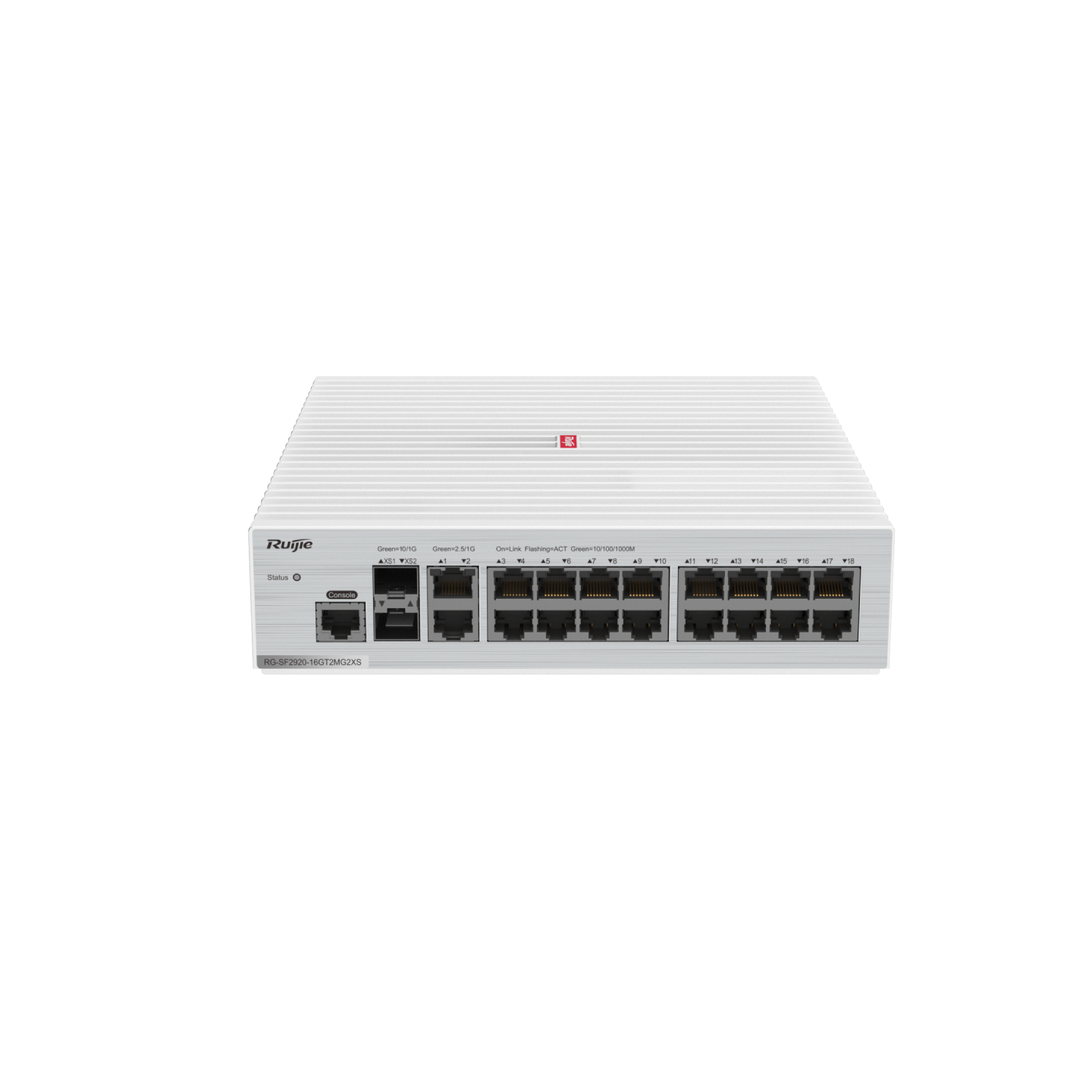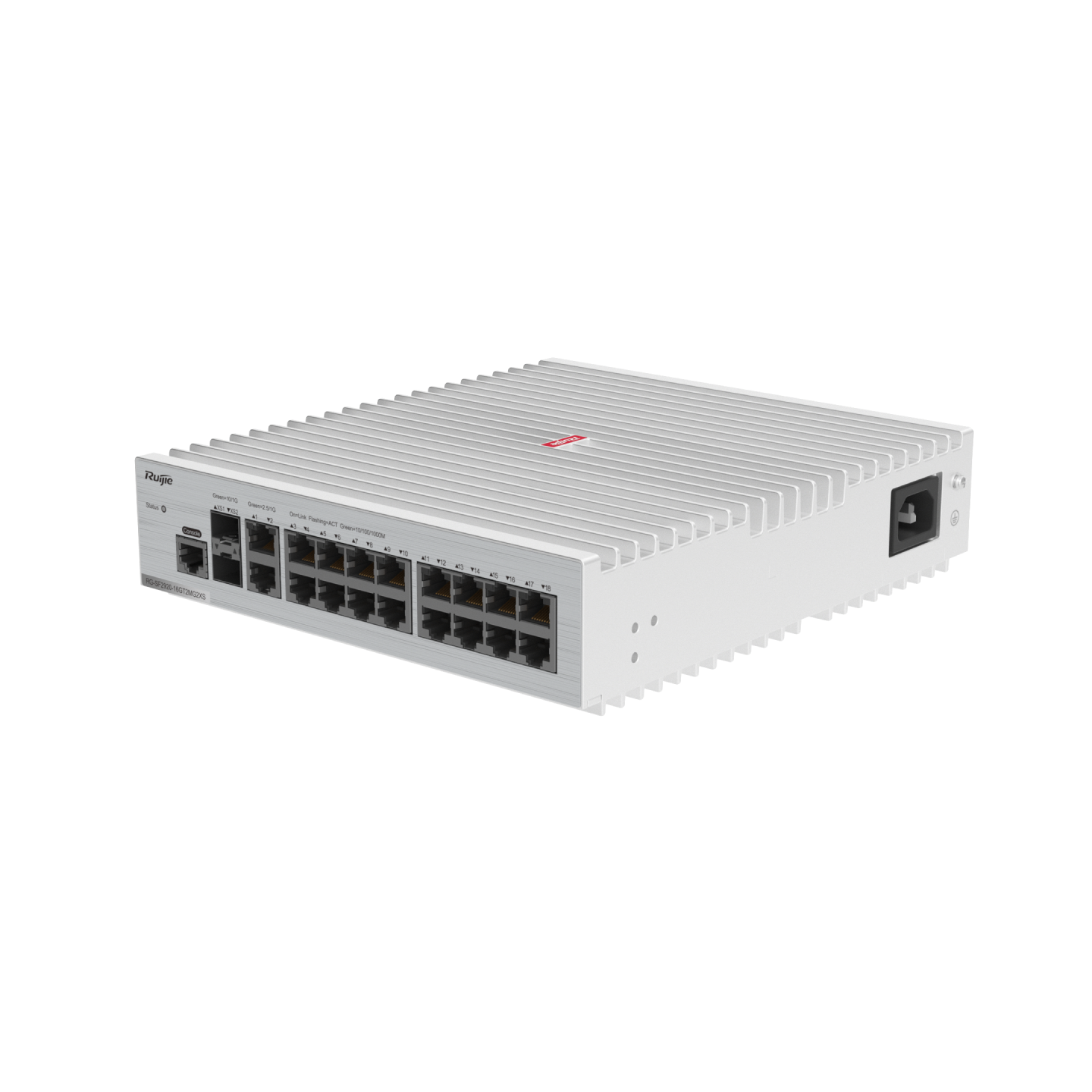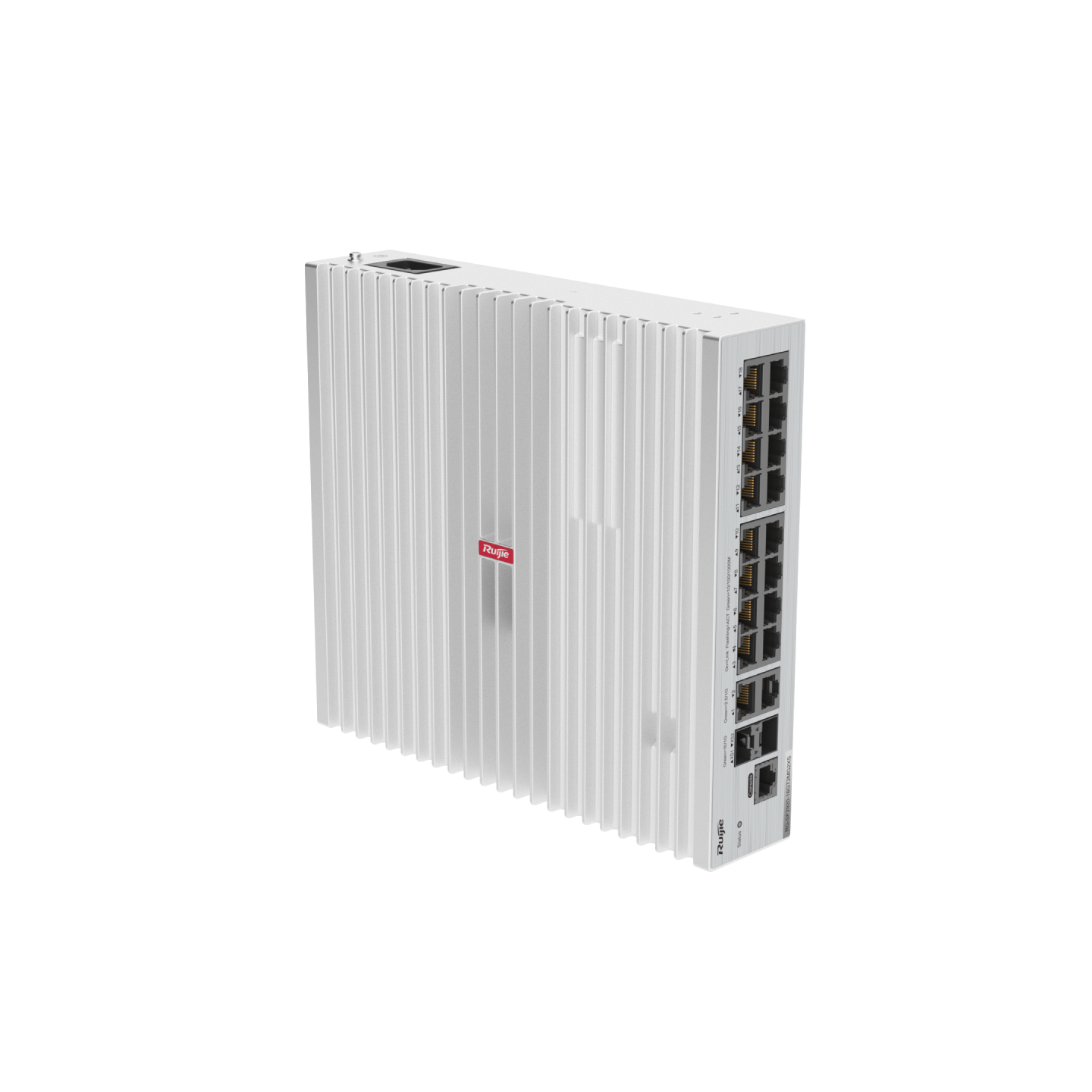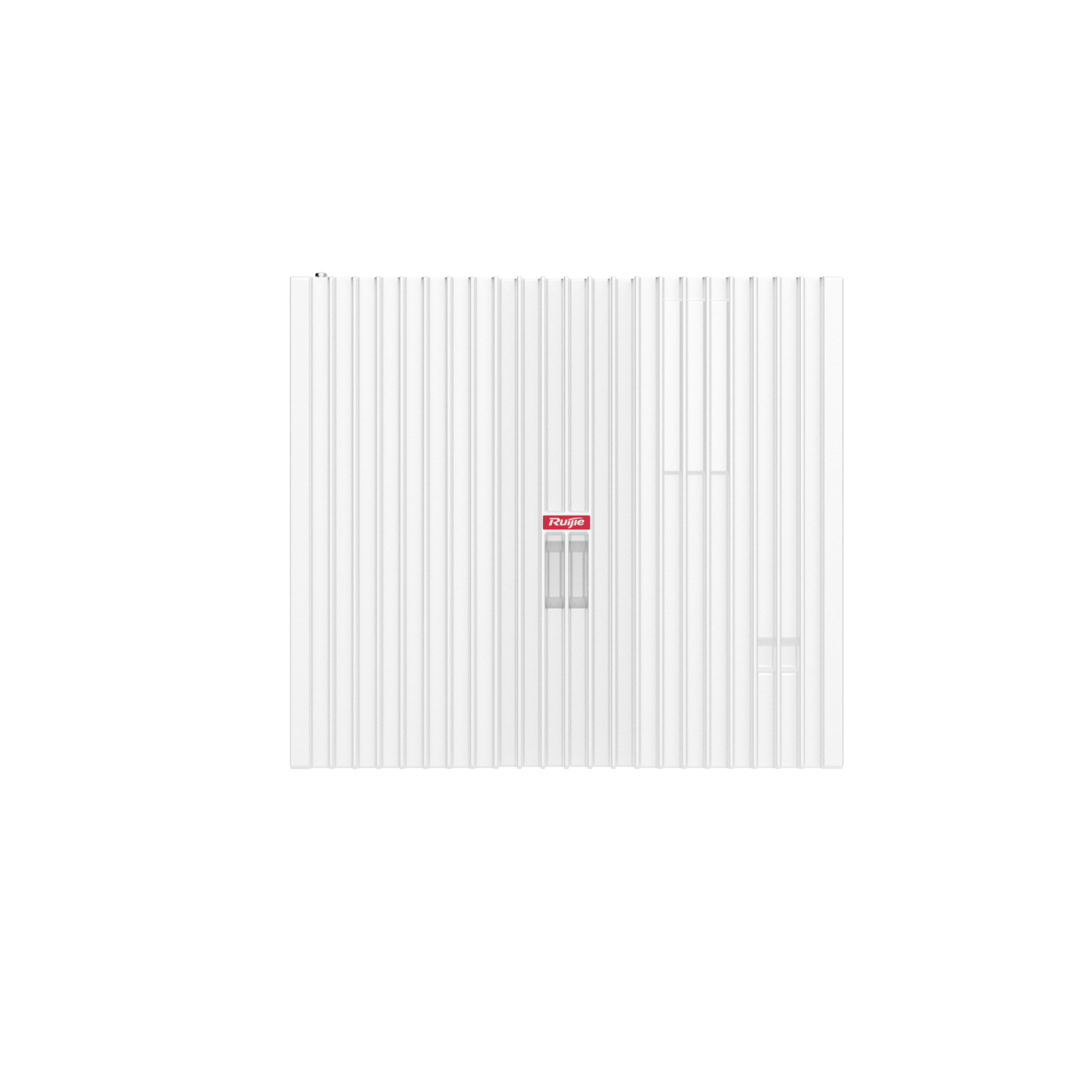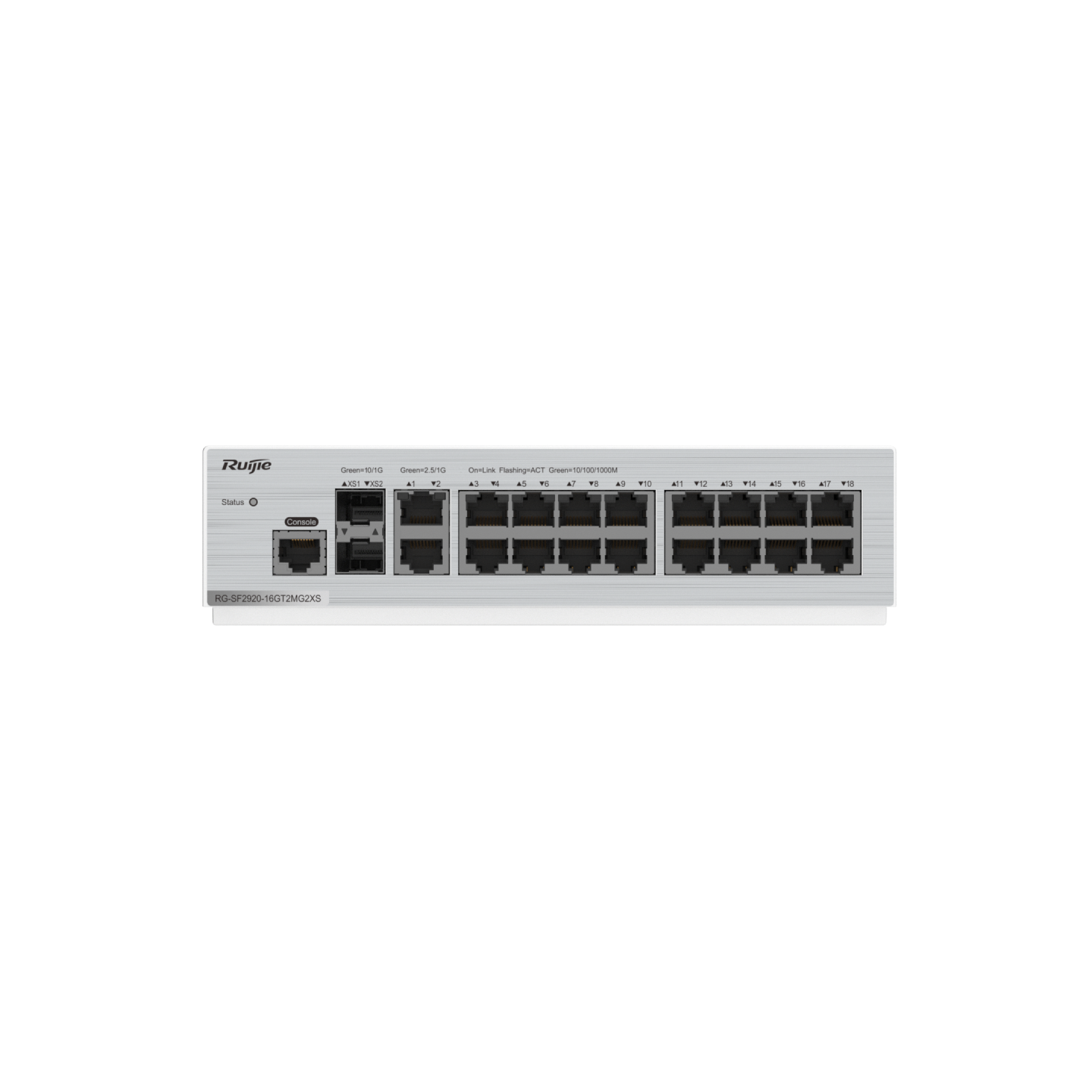| RG-SF2920-16GT2SFP, RG-SF2920-16GT2SFP-P, RG-SF2920-8GT2MG2XS, RG-SF2920-8GT2MG2XS-P, RG-SF2920-16GT2MG2XS, RG-SF2920-16GT2MG2XS-P |
| Feature |
Description |
| Ethernet switching |
Jumbo frame length: 9,216 bytes |
| IEEE 802.3az EEE |
| Maximum number of VLANs that can be created: 4,094 |
| Voice VLAN |
| Private VLAN |
| MAC VLAN MAC address-based, port-based, protocol-based, and IP subnet-based VLAN assignment |
| GVRP |
| Basic QinQ and flexible QinQ |
| STP (IEEE 802.1.d), RSTP (IEEE 802.1w), and MSTP (IEEE 802.1s) |
| ERPS (G.8032) with switching time ≤ 50 ms |
| LLDP/LLDP-MED |
| IP service |
DHCP server, DHCP client, DHCP snooping, and DHCP snooping |
| DNS |
| DHCPv6 client, DHCPv6 relay, and DHCPv6 snooping |
| Neighbor Discovery (ND) |
| IP routing |
Static routing |
| Static blackhole routing |
| RIP v1/v2 and RIPng |
| OSPFv2 and OSPFv3 |
| GR |
| Multicast |
IGMPv1/v2/v3 snooping |
| IGMP fast leave |
| ACL and QoS |
Standard IP ACLs (IP-based hardware ACLs) |
| Extended IP ACLs |
| Extended MAC ACLs |
| Expert-level ACLs |
| ACL80 and IPv6 ACLs |
| ACLs on Layer 2 and Layer 3 interfaces |
| Applying ACLs globally (hardware ACLs based on flexible combinations of the VLAN ID, Ethernet type, MAC address, IP address, TCP/UDP port number, protocol type, and time range) |
| ACL redirection |
| Traffic classification based on 802.1p priorities, DSCP priorities, and IP precedences |
| Congestion management: SP, WRR, DRR, WFQ, SP+WRR, SP+DRR, SP+WFR, and SP+WFQ |
| Congestion avoidance: tail drop |
| Rate limiting based on the inbound or outbound interface |
| Eight queues on each port |
| Rate limiting in each queue |
| Security |
RADIUS and TACACS+ |
| RADIUS authentication and authorization |
| TACACS+ |
| IEEE 802.1X authentication, MAC address bypass (MAB) authentication, and interface-based and MAC address-based 802.1X authentication |
| Web authentication |
| Hypertext Transfer Protocol Secure (HTTPS) |
| SSHv1.5 and SSHv2.0 |
| Global IP-MAC binding |
| ICMP (discarding ICMP packets of which the rate exceeds the threshold on an interface) |
| Port security |
| BPDU guard |
| Filtering of invalid MAC addresses |
| Broadcast storm suppression |
| Hierarchical management of administrators and password protection |
| IP source guard |
| ARP spoofing prevention |
| CPP and NFPP |
| DAI Portal authentication Login authentication and password security Unknown unicast suppression |
| Various attack defense functions including NFPP, ARP anti-spoofing, DHCP/DHCPv6 attack defense, ICMP attack defense, ND attack defense, IP scanning attack defense, and customizing attack defense packet types |
| Reliability |
REUP |
| Rapid Link Detection Protocol (RLDP), Layer 2 link connectivity detection, unidirectional link detection, and VLAN-based loop control |
| Load balancing LACP dynamic aggregation The LACP priority, negotiation mode, and maximum number of ports that can be aggregated can be configured. Cross-VSU aggregate interface |
| DLDP |
| IPv4 VRRP v2/v3, IPv6 VRRPv3 |
| GR for OSPF |
| NMS and Maintenance |
RSPAN and ERSPAN |
| Flow- and VLAN-based SPAN |
| sFlow (network detection technology based on packet sampling, which is mainly used for traffic statistics and analysis in heavy-traffic scenarios) |
| NTP and SNTP |
| 1:1 mirroring, N:1 mirroring, and 1:N mirroring Cross-device traffic mirroring SPAN, RSPAN, and ERSPAN |
| FTP and TFTP |
| SNMP v1/v2c/v3 |
| RMON (1, 2, 3, 9) |
| CLI (Telnet/console), Syslog/debugging, and web |
| Various types of RMON groups, including event groups, alarm groups, history groups, and statistics groups, as well as private alarm extension groups RMON used to implement Ethernet statistics, historical statistics, and alarm functions |
| CWMP |
| OpenFlow Special 1.0/1.3 |
| Periodic and automatic restoration of the port in errdisable state |
| Flow table analysis defined by all protocols Transmission of specified packets to the controller Configuring the controller's IP address and port Notifying port status changes to the controller |
| PoE |
RG-SF2920-16GT2SFP-P, RG-SF2920-8GT2MG2XS-P, and RG-SF2920-16GT2MG2XS-P: ● Electrical ports in compliance with IEEE 802.3af (15.4 W) and IEEE 802.3at (30 W) ● Automatic and energy-efficient power supply management modes ● Warm start to implement uninterrupted power supply ● Port priority |
